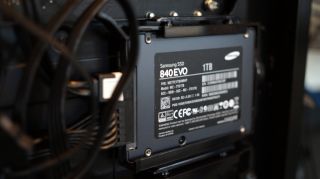
SSDs are great. They're small and fast, but their storage method is inherently flawed—writing data erodes the individual memory cells at the nano level, meaning they have a lifetime that can be measured in terabytes of data being rewritten. Most drive manufacturers conservatively estimate for 20 to 40GB per day for the length of a three- or five-year warranty, but that doesn't tell us how much abuse SSDs can actually take. Modern SSDs will still last for years of daily use, and will usually outlast more fragile spinning disk hard drives. But how many bytes of data does that add up to?
Over at The Tech Report, they decided to find out. More than a year ago, they chose six SSDs to undergo an endurance experiment. 10GB of static data—a copy of the Windows 7 installation folder and a handful of applications and movies—would be written and re-written and deleted and re-written on the drives, over and over, to see just how long they last.
The drives were: The Samsung 840 Pro, Samsung 840, two Kingston HyperX 3K, Corsair Neutron GTX, Intel 335 Series.
So far, four of the drives have bit the dust, but two—a Samsung 840 Pro and a Kingston HyperX 3K—have reached an impressive milestone: two petabytes of data writes. To put that in perspective, the average consumer SSD will likely log only a terabyte or two over the course of a few years. Under normal, non-crazy experimental conditions, it would take a thousand years to write that much data.
The full experiment check-in goes into much more detail about the performance of the drives over the course of the last year. Definitely check it out. Here's a highlight, about the different ways the SSDs fail:
"Although all SSDs are living on borrowed time, they can take different paths to the end of the road. Intel's 335 Series is designed to go out on its own terms, after a pre-determined volume of writes. Ours took its own life after 750TB—but not before its wear indicator bottomed out and multiple SMART warnings were issued.
Our first HyperX 3K only made it to 728TB. Unlike the 335 Series, which was almost entirely free of failed flash, the HyperX reallocated nearly a thousand sectors before it ultimately expired. Again, though, the wear indicator and SMART warnings provided plenty of notice that the end was nigh."
The biggest gaming news, reviews and hardware deals
Keep up to date with the most important stories and the best deals, as picked by the PC Gamer team.
As the former head of PC Gamer's hardware coverage, Bo was in charge of helping readers better understand and use PC hardware. He also headed up the buying guides, picking the best peripherals and components to spend your hard-earned money on. He can usually be found playing Overwatch, Apex Legends, or more likely, with his cats. He is now IGN's resident tech editor and PC hardware expert.
Most Popular






